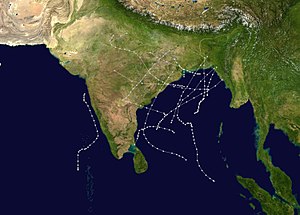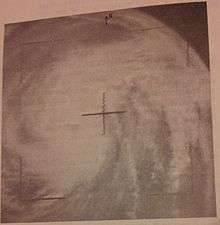1965 North Indian Ocean cyclone season
The 1965 North Indian Ocean cyclone season had no bounds, but cyclones tend to form between April and December, with peaks in May and November. The season has no official bounds but cyclones tend to form between April and December. These dates conventionally delimit the period of each year when most tropical cyclones form in the northern Indian Ocean. There are two main seas in the North Indian Ocean—the Bay of Bengal to the east of the Indian subcontinent and the Arabian Sea to the west of India. The official Regional Specialized Meteorological Centre in this basin is the India Meteorological Department (IMD), while the Joint Typhoon Warning Center releases unofficial advisories. An average of four to six storms form in the North Indian Ocean every season with peaks in May and November.[1] Cyclones occurring between the meridians 45°E and 100°E are included in the season by the IMD.[2]
| 1965 North Indian Ocean cyclone season | |
|---|---|
 Season summary map | |
| Seasonal boundaries | |
| First system formed | Unknown |
| Last system dissipated | Unknown |
| Seasonal statistics | |
| Depressions | 14 |
| Cyclonic storms | 6 |
| Severe cyclonic storms | 4 |
| Total fatalities | Unknown |
| Total damage | Unknown |
| Related articles | |
Systems
May 11 Bengal cyclone
Two cyclones that hit on May 11 and June 1 killed a total of 47,000 people.
June 1 Bengal cyclone
Two cyclones that hit on May 11 and June 1 killed a total of 47,000 people.
December 1965 East Pakistan cyclone

A cyclone hit East Pakistan on December 15, causing about 10,000 casualties.[3]
See also
- List of North Indian Ocean cyclone seasons
- List of notable tropical cyclones
- 1965 Atlantic hurricane season
- 1965 Pacific hurricane season
- 1965 Pacific typhoon season
References
- "IMD Cyclone Warning Services: Tropical Cyclones". India Meteorological Department. Archived from the original on 4 November 2008. Retrieved May 10, 2013.
- "Report on Cyclonic Disturbances Over the North Indian During 2008". India Meteorological Department. January 2009. Archived from the original (PDF) on May 29, 2009. Retrieved May 10, 2013.
- St. Petersburg Times – Google News Archive Search